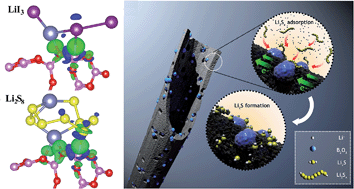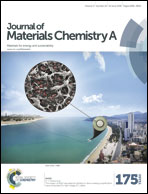Ultra-small B2O3 nanocrystals grown in situ on highly porous carbon microtubes for lithium–iodine and lithium–sulfur batteries†
Abstract
B2O3-modified carbon microtubes, which possess a highly porous structure and well-dispersed ultra-small B2O3 nanocrystals (ca. <5 nm) in the tube wall, are successfully fabricated via a facile thermal-treated process from poplar catkin, and then investigated for the first time as a capture interlayer for lithium–iodine (Li–I2) and lithium–sulfur (Li–S) batteries. After introduction of the B2O3/carbon microtube composite interlayer, the iodine cathode demonstrates a reversible capacity of 176.9 mA h g−1 after 500 cycles at a rate of 20C. When the rate increases to 100C, a high capacity of 140.7 mA h g−1 can still be obtained after 5000 cycles, which makes this the most stable iodine cathode reported for Li–I2 batteries to date. For Li–S batteries, the sulfur cathodes present excellent cycling performance with a high discharge capacity of 594 mA h g−1 at the rate of 4C. Such excellent cycle stability for the Li–S and Li–I2 batteries could be mainly attributed to strong interactions between the ultra-small B2O3 nanocrystals and polysulfide or iodine ions, which has been proven using first principle calculations.

- This article is part of the themed collection: 2016 Journal of Materials Chemistry A HOT Papers

 Please wait while we load your content...
Please wait while we load your content...